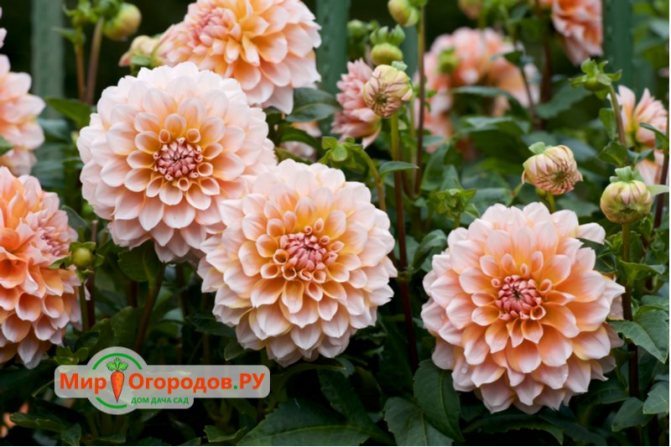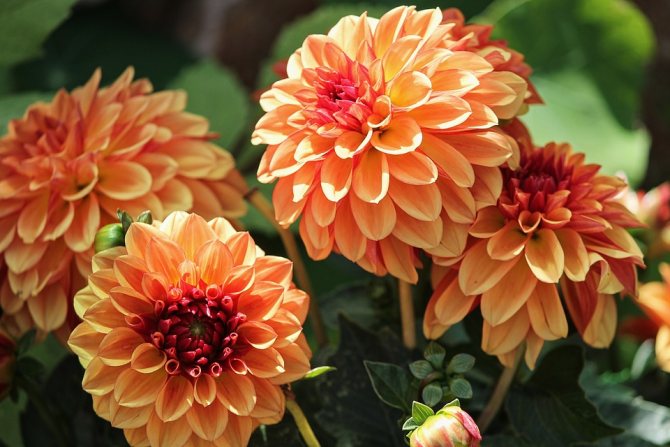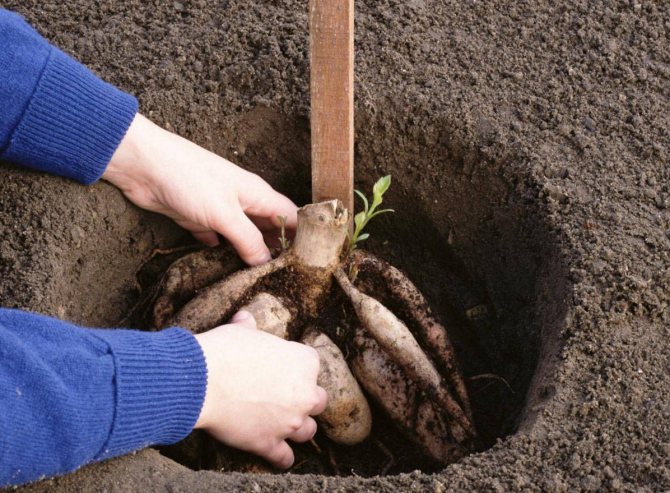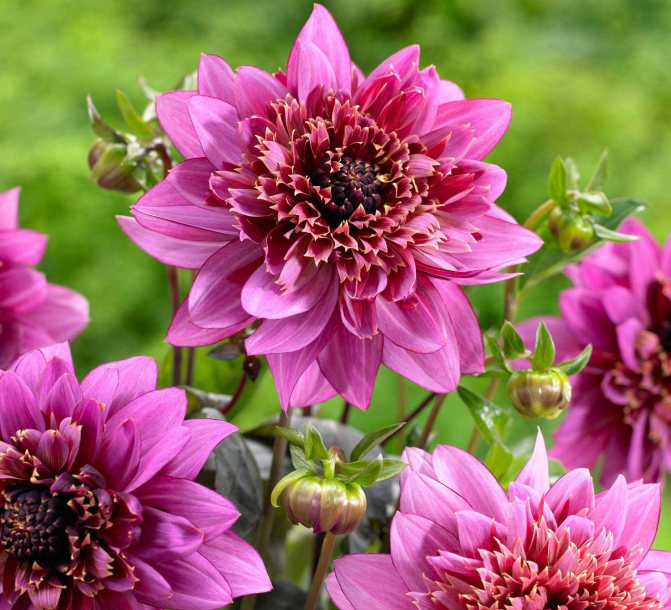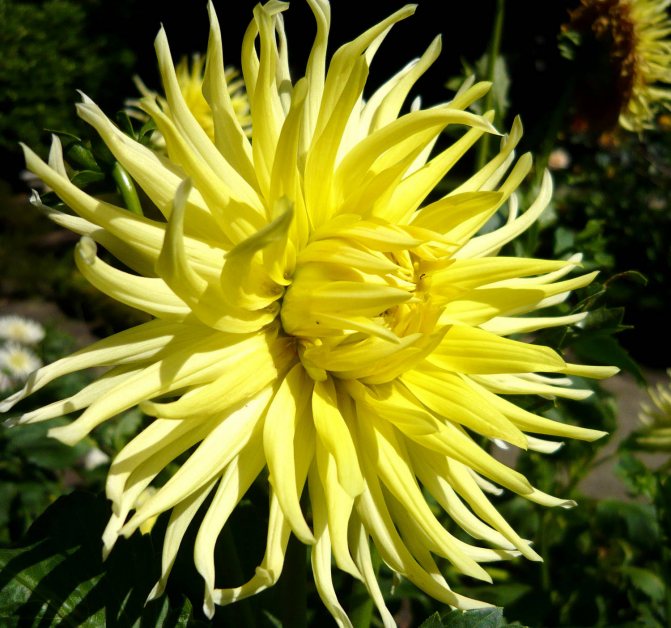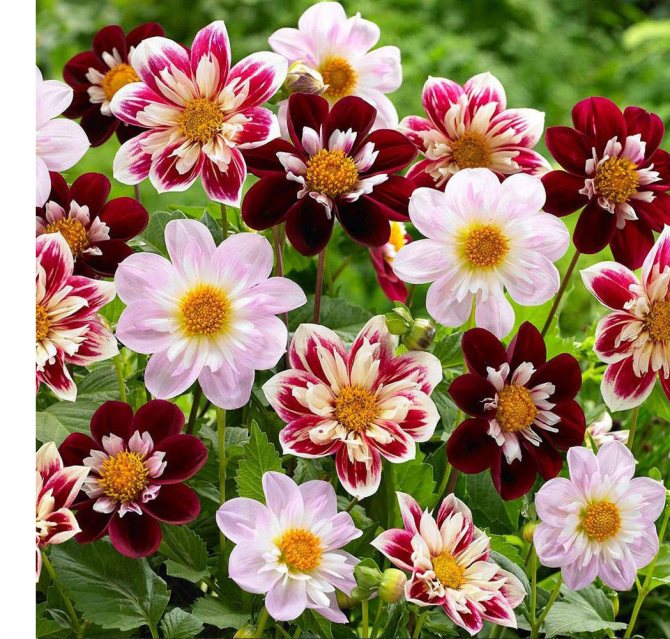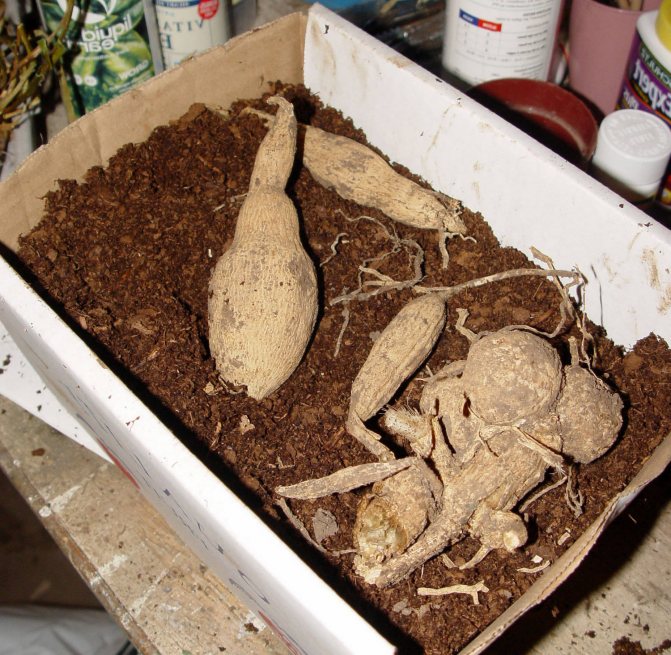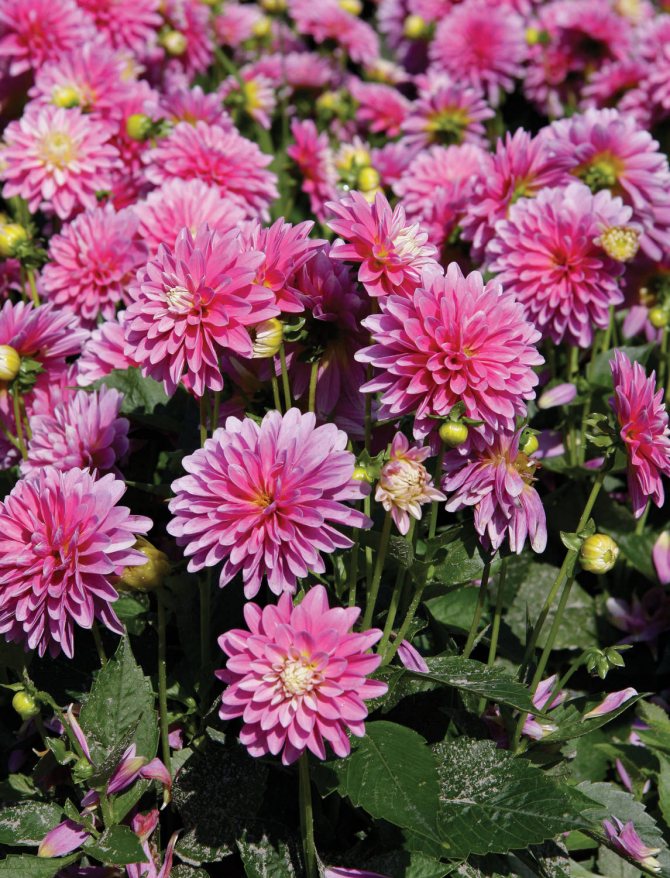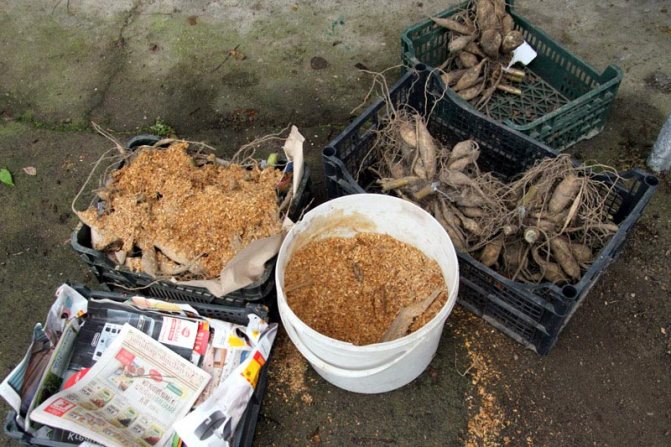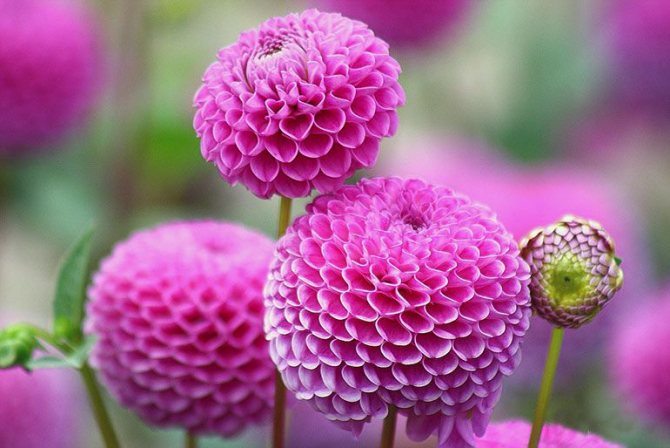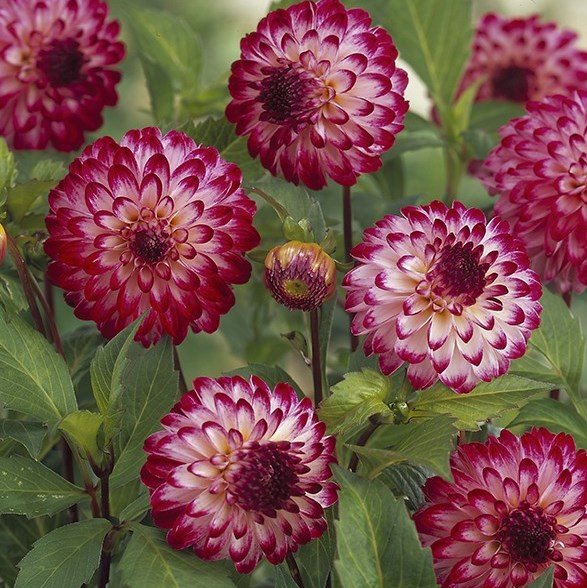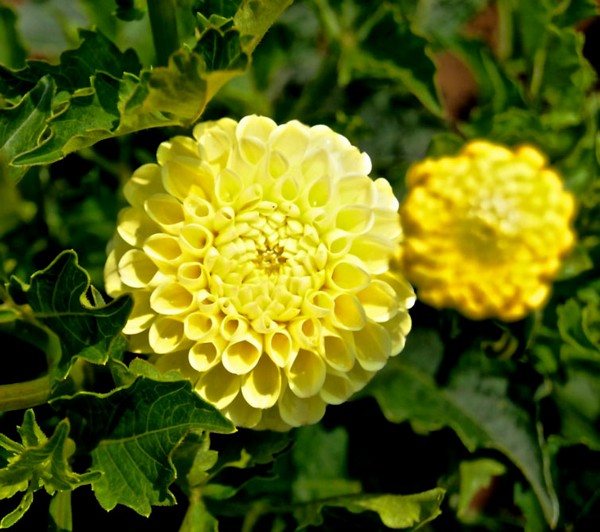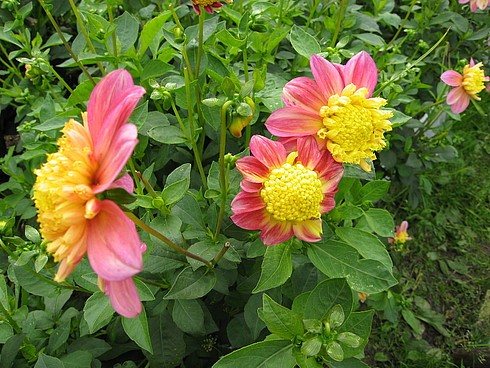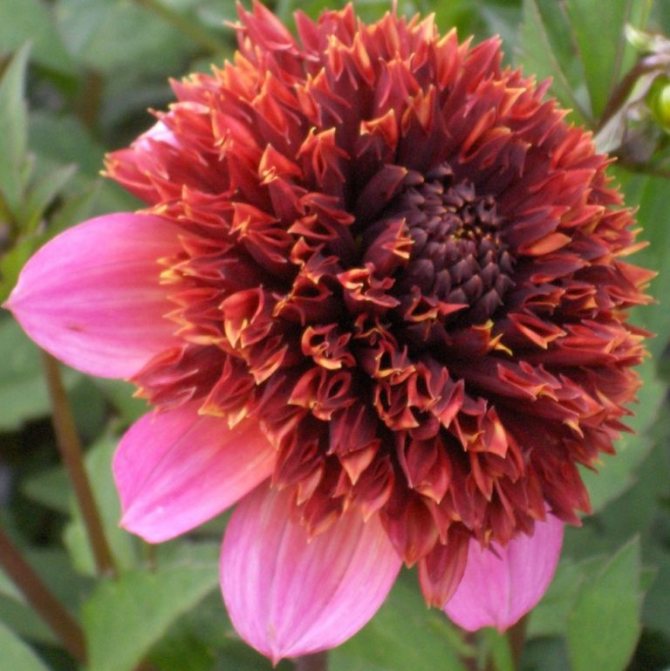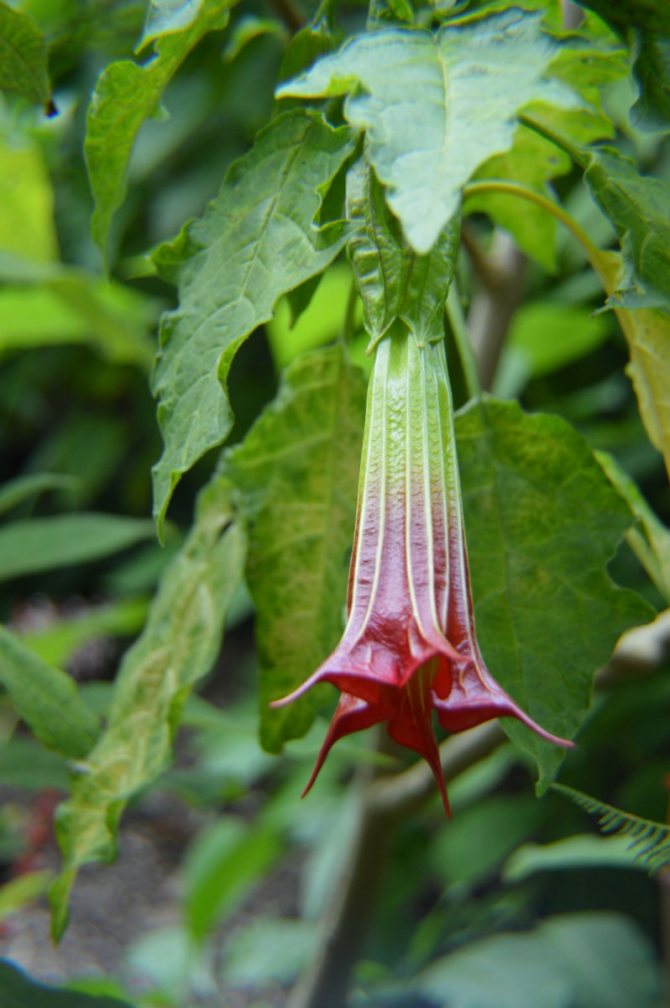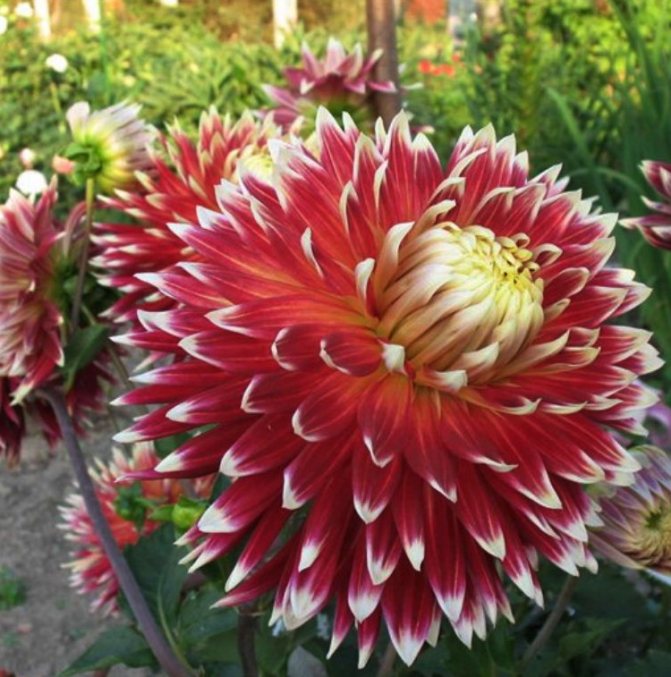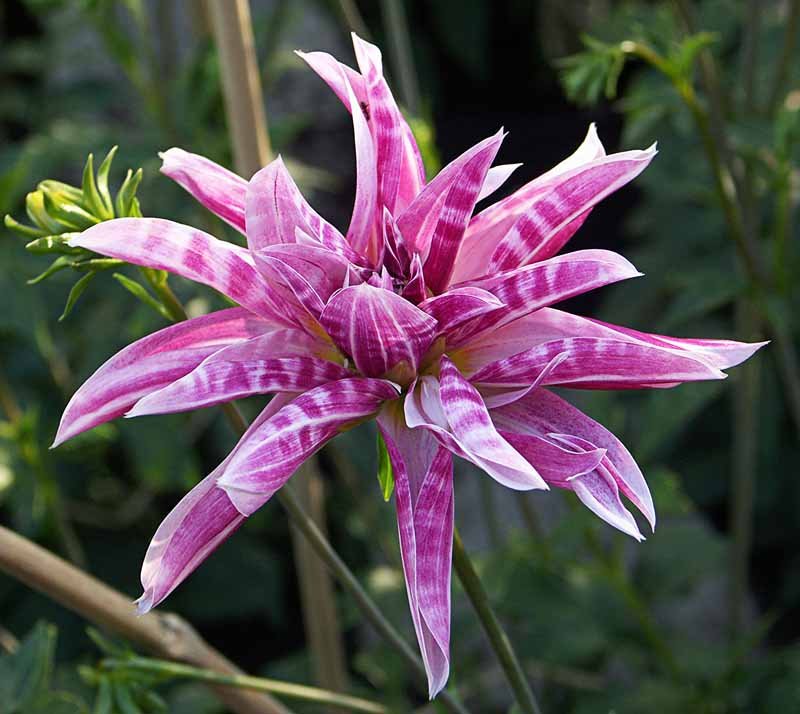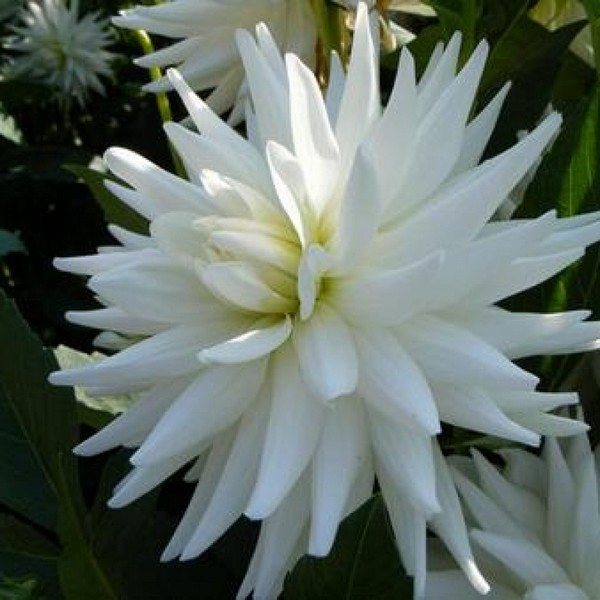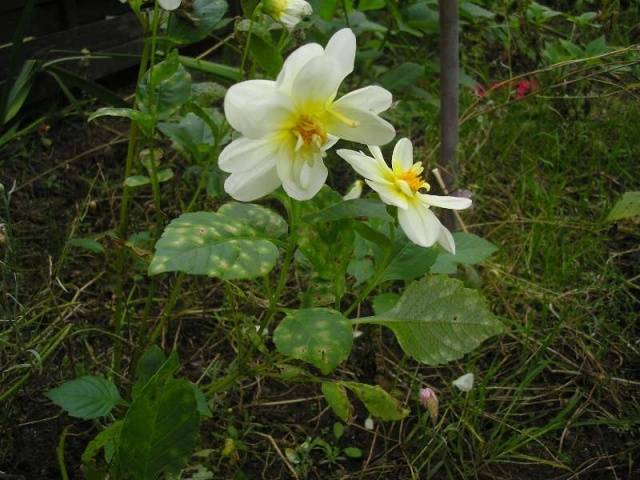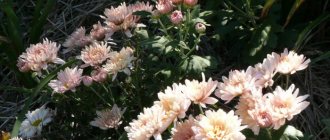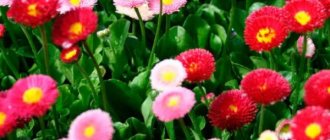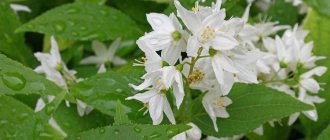Perennial dahlias do not require special care; they adapt well to the conditions of central Russia.
Another significant advantage is the long flowering period.
Today, there are 42 types of dahlias, which differ in the height of the bush, the shape of the peduncle and the color of the petals.
Most varieties are odorless, which is convenient for allergy sufferers.
Perennial dahlias - description
Perennial dahlias attract gardeners with several advantages at once:
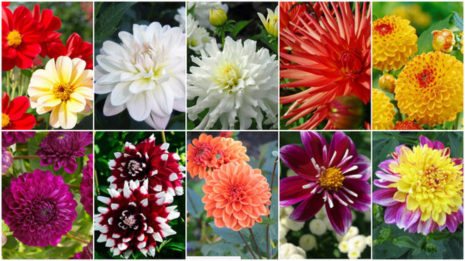
- the variety of varieties - today it is more than 15,000;
- their variety - different heights and sizes of flowers, interesting shapes of petals (elongated, bifurcated, twisted, etc.), a rich palette of colors;
- flowering duration - from summer to the first frost;
- unpretentious care;
- with proper care, they decorate the garden for many years in a row.
Plant structure
Components of a dahlia:
- inflorescence, diameter from 3 to 30 cm. A basket of inner and marginal petals. Internal - tubular, most often yellow. Edge - petal, of various shapes and shades;
- stem, height from 20 to 150 cm. Thick, but hollow inside - may break under load, therefore tall varieties require additional support for the stem;
- root system - large tubers (or root cones);
- root collar - there are vegetative buds on it, tubers are attached to it. A stem sprouts from the neck, so if it is damaged, the entire dahlia dies.
Dahlia life cycle
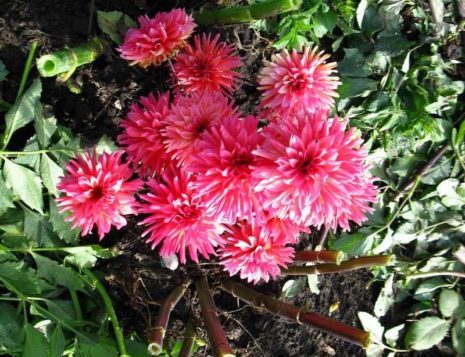

Usually dahlias are propagated by tubers. Dahlias, grown from seeds or cuttings, form a root-tuber in a year, suitable for planting the next year.
For the winter, the tubers are removed from the soil. With the onset of spring, the tubers germinate, shoots appear from the "eyes" on the root collar. After the establishment of heat, planting is carried out in the ground, the tubers take root, the stem grows, inflorescences appear. Flowering and seed formation continues until frost. For the winter, the stems are cut, the tubers are carefully dug out, cleaned and stored until the new growing season so as not to damage the root collar.
Growing conditions
Dahlias are unpretentious in care, but for their successful growth and flowering, as well as obtaining healthy tubers, a number of conditions must be observed.
What dahlias love:
- heat. They can be planted only when frost is no longer threatening, otherwise the flowers will die;
- shine. For successful development, they need to spend 6-7 hours a day under the sun;
- moderate watering. Dahlias are equally poor at tolerating aridity and excess moisture. The soil should be moist, but not flooded with water;
- loose, moderately fertile soil, the best option is sandy or loam;
- free space. When planting, you should take into account the estimated size of the bush and do not plant them close to each other.
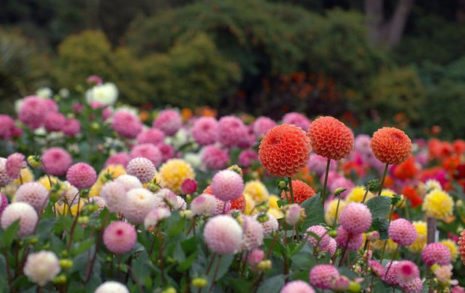

What dahlias dislike:
- improper wintering. Tubers left for the winter in the open field will die. They need winter rest in a cool, dark place;
- lack of light. Dahlias should not be planted in shaded areas. In insufficient light, the flowers will be small and dim, and the resulting weak tubers will not be able to successfully overwinter;
- improper watering. Lack of moisture will lead to poor plant growth. Excessive watering will cause rotting of the tuber and the death of the dahlia;
- excess fertilizer.It leads to overgrowth of green mass to the detriment of flowering. Overfeeding with nitrogen fertilizers is especially undesirable.
- strong wind. Dahlias should not be planted in open areas. A strong gust of wind can break a hollow stem weighed down by a heavy flower.
- crowded landing. Dahlia bushes grow in breadth, which must be taken into account when planting.
Choosing the right place
When choosing a place where dahlias will settle in the future, you need to take into account the purpose of their cultivation - decorative or reproduction for sale. If the plans include the implementation of dahlia tubers, then the planting scheme will differ from that when growing these flowers to decorate the site.
The recommendations below for planting dahlias and caring for them in the open field are relevant for central Russia and the CIS countries (Primorsky, Altai Territories, the southern part of the Khabarovsk Territory and Western Siberia, the South and Middle Urals, the Baltic States, Belarus, the northwestern part of Ukraine) ... When growing in more southerly regions and countries, you will have to make adjustments for the climate features, shifting the timing of planting and harvesting, as well as changing agricultural technology.
When choosing a place to grow dahlias, you need to take into account their features, including:
- high water demand (the higher the air temperature, the more water is needed);
- short growing season;
- the need for support and a garter due to the fragility of the stems.
It is important to create an optimal microclimate that will allow you to get the maximum decorative effect of dahlias in a relatively short period. The landing site should be protected from cold north, north-east and north-west winds and drafts, warm up well. In combination with a low air temperature (from +1 to -4 degrees), strong winds can cause dahlias to freeze, especially if they were recently planted from greenhouses or greenhouses and did not have time to get the necessary hardening.
In the southern regions, the danger is posed by dry winds - northeastern, eastern and southeastern winds carrying heated dry air. They dry out the soil and the aboveground part of the dahlia, causing the young foliage and plant tops to be burned.
To protect the flower beds with dahlias from the winds, the site is planted with trees, ordinary or fruit, using fences or protective strips. Often the site is given a slope - south or south-east for the middle zone and north or north-west for the southern regions.
Important! Lowlands, hollows, valleys should be avoided, where cold air usually accumulates and late spring frosts often occur.
In the shade of trees or fences, dahlias grow beautifully and retain a high decorative effect if the sun illuminates them for at least half a day. At the same time, planting these flowers in the area of \ u200b \ u200bthe root system of large tall trees should be avoided, since they will not be able to bloom normally and form viable root tubers.
When choosing a site for planting dahlias, great attention should be paid to the issue of the occurrence of groundwater. They should not rise above 60-70 cm from the ground surface. If the water rises higher in the area, a flower bed with dahlias should be artificially raised to protect their root system from decay.
In hot southern regions, on the contrary, they often arrange flower beds with dahlias in a depression surrounded by ramparts of earth. At night, this depression is filled with water to ensure sufficient moisture supply to the roots.
Breeding methods for perennial dahlias
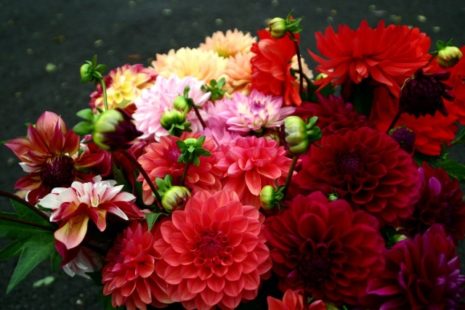

For growing perennial varieties, you can plant seeds, cuttings or tubers.
Seed propagation
Seeds are planted in seedling boxes and outdoors when warm weather sets in. But experienced gardeners find this method unreliable, more suitable for annual dahlias. When grown from seed, dahlias can lose the quality traits of the variety.
Propagation by cuttings
Cutting, carried out according to the rules, allows you to grow a healthy, high-quality bush.
To obtain cuttings, the tubers begin to germinate in January-February by placing them in sawdust (sand) and watering them moderately to maintain moisture. The sprouts that appear grow up to 6-10 cm, and then they are cut or broken off together with a small "heel" - part of the root collar. The sprouts reach the required length by about April-May.
TIP!
After cutting off the sprouts, the tuber gives new shoots. You can grow up to three generations of sprouts, but each time the quality of the planting material deteriorates.


Cut cuttings are planted in wet sand and covered with foil (glass, plastic bottles). Before germination, cuttings must be watered and ventilated. Then they are planted in open ground.
TIP!
It is better to germinate cuttings in small containers - the lack of free space forms large, strong, high-quality tubers.
Reproduction by dividing tubers
3-4 weeks before planting in open ground, tubers must be germinated - approximately March-April. The tubers are brought into the house and examined. After removing the damaged areas, the tubers are disinfected with a weak solution of potassium permanganate. Sections can be sprinkled with activated carbon powder. Prepared tubers are planted with their root collar upwards in wet sand or sawdust and covered with a layer of about 6 cm. For germination, sunlight and an air temperature of about 200C are required. After the appearance of "eyes", the tubers are recommended to be divided. This method strengthens and rejuvenates the plant, avoiding excessive density of future bushes. Each part should have two or three "eyes". After germination, the split tubers are ready for open field.


Tuber propagation
Growing dahlias from tubers gives good planting material. In addition, it rejuvenates the adult plant.
If the tuber is not divided, the bush will quickly grow old and die in a few years. The division is carried out in autumn or spring.
It is better if there are developed buds and several roots on the plot.
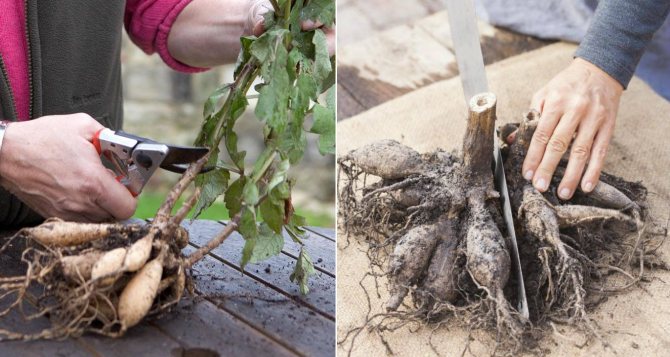

Before work, the tuber is cleaned of dried parts and last year's stems.
Large tubers are cut in half lengthwise.
Excellent planting material is obtained from them.
Special attention is paid to the technical side of the issue.
Choose the sharpest knife for cutting. After each subsequent cut, the blade is disinfected to avoid the spread of possible infection.
The strips are not cut across, they may die because of this.
Before planting, the cuts of dahlias are treated with a manganese solution, dried and planted in the ground.
It is necessary to sprinkle the growth buds by 10 cm.
If the tubers will grow in a pot rather than in a flower bed, they can be shortened.
Preparation before landing
Planting material needs preparation for planting.
Selection of seedlings
High-quality planting material is required. If he prepares himself, then you need to take care of the correct wintering. For planting and obtaining cuttings, only healthy large tubers are selected.
If you buy material for planting, then you need to contact trusted sellers, shops and nurseries. Tubers and cuttings without flaws, strong, with already appeared sprouts are selected for purchase.
Seat selection
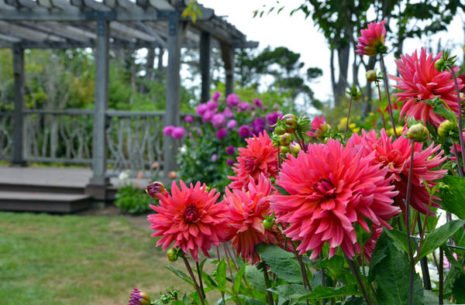

The landing site must be illuminated by the sun for at least 6 hours a day. Dahlias must be protected from strong drafts. Flowers will not grow in wetlands; care should be taken to drain.
It is necessary to evaluate the planting site from an aesthetic point of view, so that future flowers fit optimally into the overall composition of the flower bed.
Soil preparation
The best option is moderately fertile loamy or sandy soil. Wetlands are categorically not suitable.
The earth must be well dug up with the addition of compost, with increased acidity, wood ash or lime is added, the increased alkali compensates for sour peat.
Pompom
| Little Robert
|
| Deepest Yellow
|
Landing in open ground


It should be replanted after warming up the soil, when the frost has already passed, around the beginning of May. The tubers are placed at a depth of 7-10 cm. The holes are placed at a distance that takes into account the growth of future bushes: undersized - 50-60 cm, tall - 80-90 cm from each other. Fertilizers and sand mixed with soil are added to the holes. For tall varieties, a support peg is immediately fixed next to it.
The tubers are placed in holes and covered with soil. The distance from the root collar to the surface is no more than 2-3 cm. After planting, watered with warm water.
Anemone
| Lambada
|
| Honey
|
| Phantom
|
Care features
Caring for dahlias is simple, but a must.
Watering
Watering frequency depends on air temperature and soil type. The soil should be moist, but moisture should not be allowed to stagnate at the roots so that they do not rot. Therefore, when selecting a site for planting and preparing a hole, you need to take care of good drainage.
Watering should be done either early in the morning or after sunset. When watering, water should not fall on the leaves - rotting may begin. Watering stops in September
Loosening and mulching


A dried crust may appear on the soil around the bush, so the soil should be loosened to allow oxygen to flow. This should be done very carefully, because the tool may damage the roots.
You may be interested in: When to dig dahlias in the fall in the middle lane When to plant dahlias in open ground in the spring When to dig dahlias in the fall and how to store them before planting in the spring?
You can carry out mulching - surround the hole with a ring of peat, sawdust or compost 4-5 cm high, to protect against weeds and retain moisture.
Top dressing
The first feeding is carried out 10 days after planting. Then fertilizers are added at intervals of two weeks, alternating complex mineral and organic fertilizing. Nitrogen fertilizers should be limited and excluded from the second half of August. In the fall, experienced gardeners are advised to carry out phosphorus-potassium dressing.
For dahlias, wood ash is very useful, which serves as additional protection from pests if you scatter it around the bushes.
TIP!
Fertilizers should be applied after abundant watering - water reduces the concentration of fertilizers, otherwise they can burn the tubers.
Bush formation
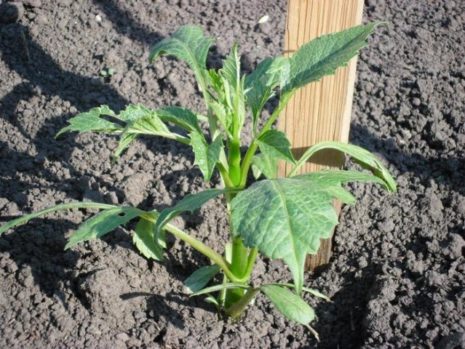

Using simple operations, you can form a bush as you wish: accelerate flowering, increase the number of flowers and their size, etc.
Grasshopping - removing the side shoots of dahlias. This will speed up flowering, increase the size of the flowers and increase the length of the stem.
Pinching - removal of the central inflorescence on each shoot immediately after emergence.The remaining buds will produce larger inflorescences.
Pinching - pinching of the shoots that have appeared after the buds appear. The number of pinches depends on the plant: the stronger the bush, the more shoots you can leave. Pinching improves bud development.
Withered flowers should be picked off.
Low-growing bushes do not need to be formed.
Pest and disease control
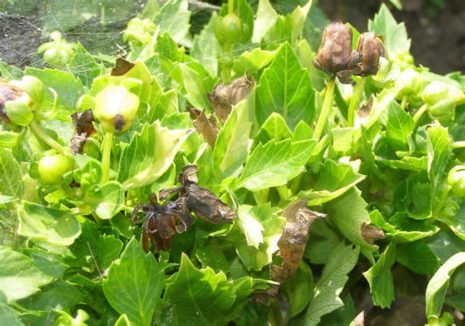

Aphids, slugs and two-tailed dahlias eat green dahlias. Garlic or soap solution helps with aphids. Slugs and earwigs are repelled by a decoction of celandine and wormwood. To protect against them, the area around the dahlias is also sprinkled with wood ash. For prevention, insecticides are used.
Excessive watering can lead to gray mold disease and fusarium wilting. In the first case, the leaves are covered with brown spots and fall off. Reduce watering, remove diseased leaves and spray with fungicide. With fusarium wilting, due to contact with moisture, the roots begin to rot. It is necessary to drastically reduce watering.
Dangerous "black leg" - the stem turns black and dies. At the first sign, it is necessary to disinfect the soil with a 1% solution of potassium permanganate.
Storing tubers in winter
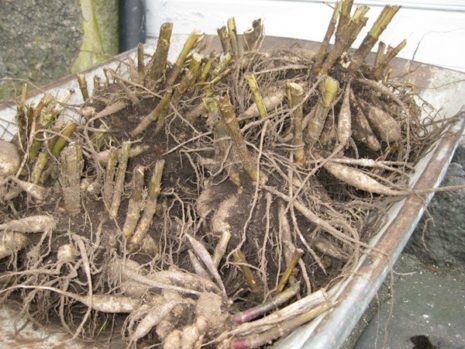

It is necessary to take care of the tubers wintering. They stop watering them in September so that the tubers do not accumulate moisture. After frost, the wilted greens are cut off, leaving only 10-15 cm of the stem. After 15 days, the tubers are carefully dug out, cleaned, dried. For storage, the tubers are placed in sand or sawdust and stored all winter in a cool room.
Bush formation
In the case when the reproduction of dahlias took place in tubers, it is recommended to leave the two strongest shoots for each seedling, removing all the rest as early as possible. Cuttings are grown, as a rule, in one stem, sometimes pinching the top above the third internode to add splendor to the bush.
For large-flowered varieties, a mandatory measure is the regular and complete removal of all stepchildren formed on the stem - lateral shoots in the leaf axils. This is done as early as possible and as close to the stem as possible. If the stepchildren are not removed, especially on the lower part of the stem, then the growth of dahlias slows down, the flowering decreases, and the size of the flowers decreases. In addition, stepchildren close to the ground often break off, and fungal infections can easily occur at the site of the break, which will cause the death of the entire plant.
The removal of stepchildren is carried out regularly, from the moment of planting and until the buds are formed. Lateral shoots are removed to the internode preceding the one where the bud was formed.
Important! Dwarf, pompom, collar and small-flowered types of dahlias are not stepchild.
Quite a few species and varieties of dahlias need to be removed not only stepchildren, but also buds. This is especially true for those plants that are grown for further cutting or participation in exhibitions.
As a rule, on the stems of dahlias, buds are formed in groups of three. The middle bud usually develops faster than the others, but at the same time it has a short peduncle, which is not very convenient for cutting. Therefore, the central bud is removed, after which the remaining two develop faster, have a longer peduncle and are distinguished by lush flowering.
During the flowering period, in order to preserve the decorativeness of the plant, faded inflorescences should be removed daily, which spoil the appearance of the bush.
Formation of undersized bushes
Almost all varieties of dahlias are tall - from 160 cm and above. If you need to get a stunted plant, you need to follow the following algorithm:
- At the end of February, parts of the tubers are planted in nutrient soil and placed in a well-lit place at a temperature not lower than + 15-20 degrees.
- After the emergence of shoots, 1-2 are left, the most powerful. The rest can be used as cuttings.
- Above the fourth pair of leaves at the bush, pinch the top.
- As a result, two stems develop from one, each of which is pinched again after the second pair of leaves.
With such a pinching system, the bush does not grow more than 1 meter in height. The grazing of such dahlias is carried out according to the general scheme.
Classification of perennial dahlias
More than 15,000 varieties are divided into 10 groups according to the structure of the inflorescence.
Simple dahlias (non-double)
Average height (up to 60 cm). The diameter of the inflorescences is up to 10 cm. The core is flat, around oval petals in 1 or 3 rows. Various colors. Varieties: orange-red Orangeade; light pink Princess Matie Rose.
Anemone


Height up to 90 cm. The "tubule" core is surrounded by 1-3 rows of oval petals. Various colors, including two-tone types. Varieties: scarlet Comet; bronze Vera Higgins.
Collar
Tall varieties, up to 120 cm. The diameter of the flower is 10 cm. The core, which is made up of tubular petals, is surrounded by a "collar" of a short row of folded petals. The bottom row is large oval petals. The petals of different rows are colored differently. Varieties: Red and Cream Chimborazo; scarlet and gold LaGioconda.
Peony
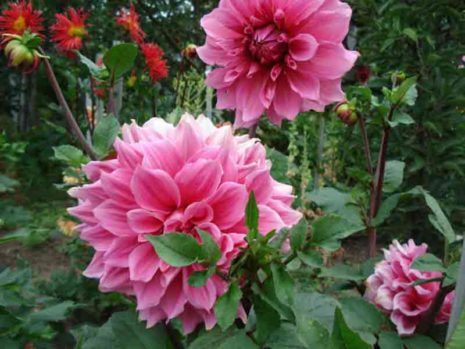

Height up to 120 cm. Flower diameter up to 15 cm. Petals are large, oval, in several rows they surround the center of tubular petals. The core is usually yellow. Varieties: Crimson Symphonia; red BishopofLandaff.
Decorative
Height up to 150 cm. Terry flowers of different shades differ in a wide variety of sizes. The center of the inflorescence of tubular petals is surrounded by several rows of large, flat petals. Varieties: huge purple Jocondo; large sunny Thames Valley.
Spherical
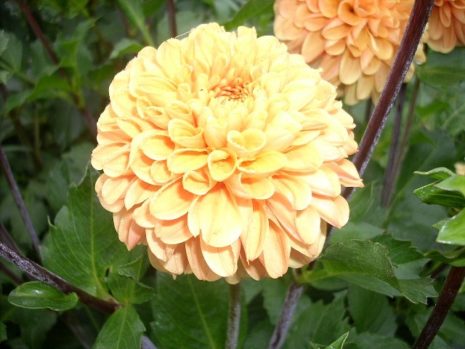

Height up to 120 cm. Flower diameter 8-15 cm. The flower has the shape of a slightly flattened ball. The lower petals are slightly curled. Varieties: lemon Esmonde; scarlet Doreen Hayes.
Pompom
The flowers are small in size, no more than 7 cm in diameter. The petals rolled into narrow tubes form a flower in the form of a ball in several rows. Varieties: pink Noreen; gentle lavender Hallmark.
Cactus


Height up to 150 cm. The diameter of the flower is from 8 to 25 cm. The petals are rolled into narrow tubes, sticking out like cactus thorns. Several rows of petals form a "prickly" inflorescence. Varieties: white-pink Stars Lady; bright orange Park Record.
Semi-cactus
They differ from cactus only in that the petals are twisted not completely into tubes, but in half. Varieties: white Aspen; orange-red Autumn Fire.
Mixed
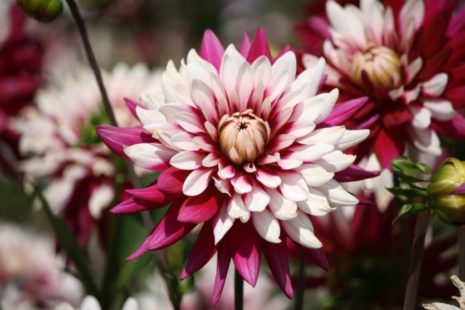

The features of the inflorescences of these varieties do not fall under any group. For example, more orchid-like orange and pink Giraffe, reminiscent of chrysanthemums in different shades of Andries Wonder.
Group variety of low and high grades
As in the case of other groups, among the dahlias there are varieties of all flowers except blue, in which these beautiful plants do not bloom. You can choose among:
- low grades - for framing borders and pots;
- medium and high - used in flower beds, beds, in large compositions.
Low grades
Among the lowest single dahlias, Topmix varieties stand out, available in several colors, including:
They have green leaves, a dense bush, and in good conditions form a large number of flower buds throughout the summer. Dahlias Topmix is planted in containers, low beds, the plants reach a height of 30 cm.


Dwarf dahlias, photo
These are varieties of low varieties, branched and compact with double, semi-double or individual flowers growing up to 60 cm in height. They are available for planting in the form of tubers, seedlings or seeds. Numerous varieties of double or semi-double-flowered dwarfs are popular as seed mixes, for example:
- "Redskin" - 50 cm high;
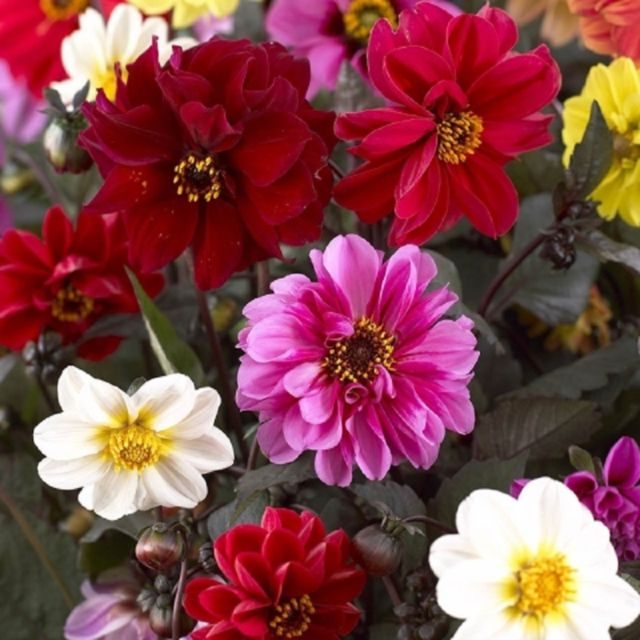

- "Figaro" - 30 cm high;


- "Rigoletto" - 30-40 cm.
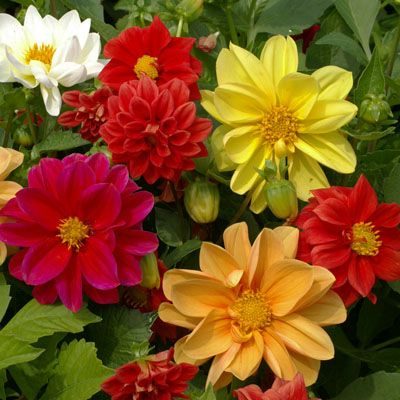

Among the single-flowered dwarf dahlias, the very low varieties offered as seeds should be mentioned:
- Top Mix;


- Mignon;


- "Piccolo";
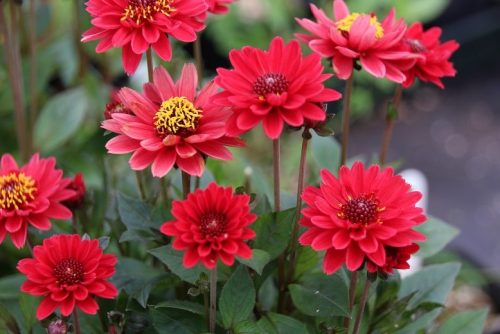

- Coltness.
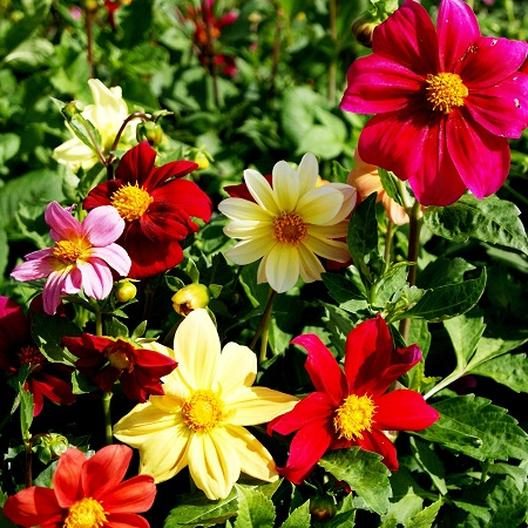

These varieties are mainly used for:
- beds in small gardens;
- flower pots on terraces;
- flower beds in front of the house.
Dwarf varieties require the following conditions:
- solar position, at least 6 hours of insolation;
- quiet calm positions;
- permeable soils, fertile, soil with the addition of compost;
- plants should be fertilized regularly every 2 weeks from the beginning of flowering;
- constantly need to maintain the moisture content of the substrate;
- it is necessary to systematically remove wilting flowers, the shoots should be cut, keeping the compact shape of the bush.
Reproduction: seeds are sown at home in March. The overwintered tubers are planted in pots at room conditions, from mid-May they are transplanted to the beds.
Pests and Diseases: In rainy weather, fungal diseases can develop on the garden bed, manifesting as green-yellow or gray-brown spots. Infected leaves should be removed, the plants are sprayed with copper preparations.
Medium-sized varieties
If slightly taller stems are needed, varieties from the Mignon group will work great. These beautiful plants grow to a height of about 50 cm. They are generously covered by rather large, eight-petalled inflorescences with a diameter of about 5-7 cm. They form dense inflorescences that cover the beds, effectively competing with weeds. They usually bloom in one shade, in pure primary colors.
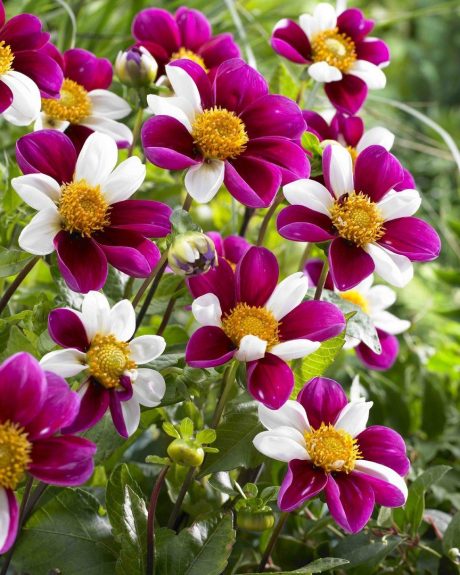

High grades
Tall single dahlias with dark leaves will decorate tall beds, including:
- pink variety "Roxy";
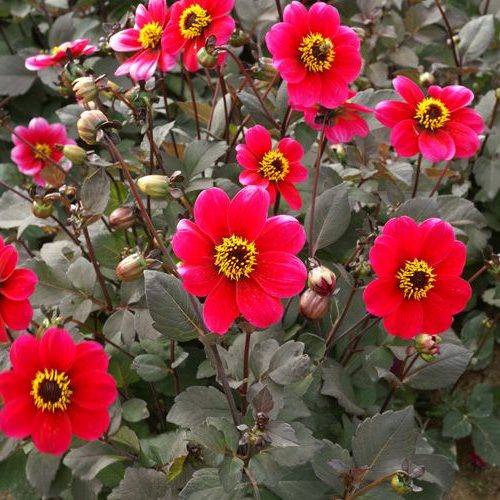

- creamy orange-red "Sunshine".
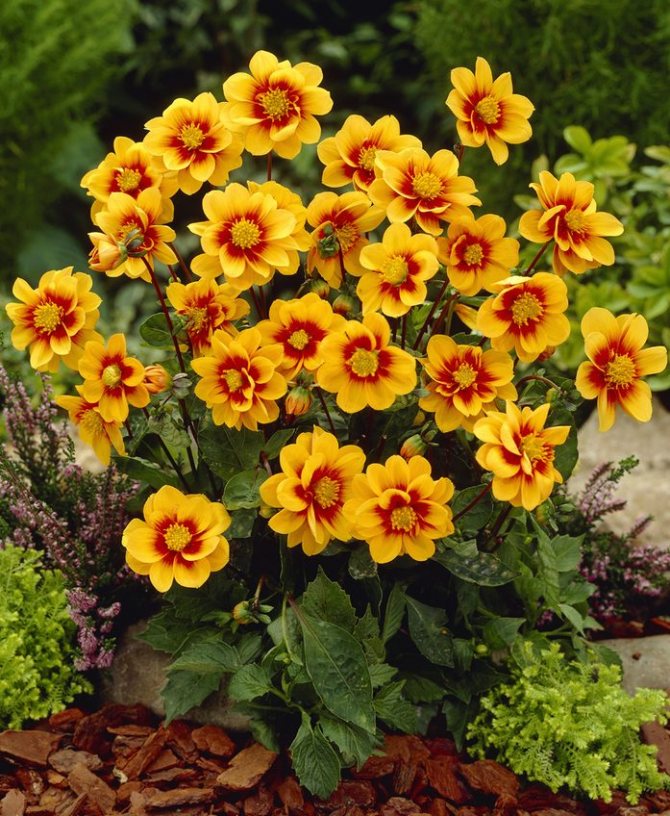

Their leaves stand out in the beds even before flowering, in contrast to the greenery of other plantations. Delicate flowers go well with delicate flowers of tall perennials and annuals, with herbs. This is one of the few options for dahlias that match natural-style beds. Plants of this type are very popular, and as a result, many new products have appeared on the market with dark leaves and delicate flowers.
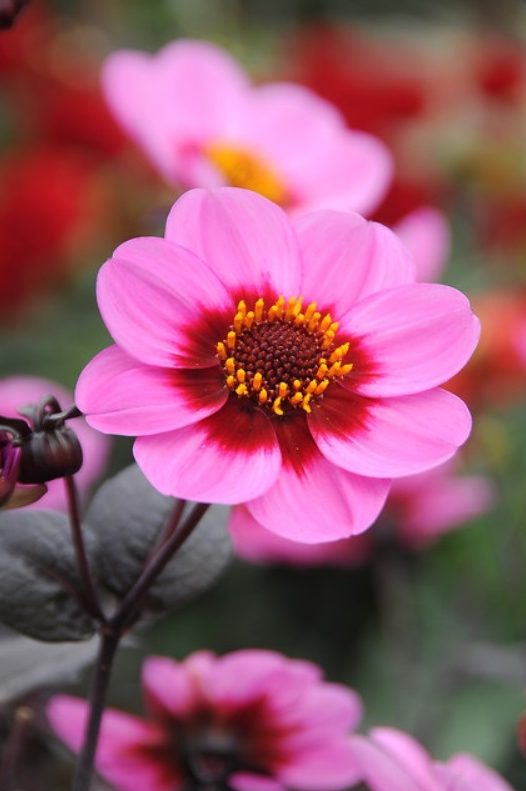

Variations that do not fit into those described are included in the so-called groups of different dahlias, for example:
It is advisable to provide dahlias with very fertile soil, it is important to choose sunny areas, a lot of moisture is needed. When grown in containers, the following should be provided:
- frequent feeding of fertilizers for flowering plants;
- agrotechnical procedures - systematic cutting of faded flowers.
Dahlias are wonderful plants with versatile uses. They are ideal for creating garden groups on lawns, flower beds, flower beds, cut flowers. Low grades - for decorating terraces and balconies.
Dahlias are one of the closest relatives in the Astrov family. They have a huge range of bright colors and unusual shapes. Everyone can find a favorite dahlia flower for themselves, as there are more than forty species of these magnificent plants.
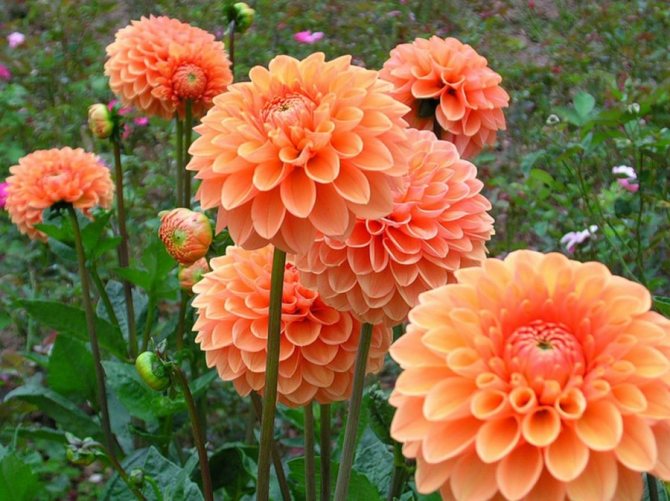

A varied color range of dahlias will fill your flower bed with a riot of colors, depending on their type. You can choose a certain variety and you will have a themed garden, for example, in yellow or pale pink, or maybe you like rich red or all the colors of the rainbow? In this case, dahlia flowers will be a real find for you.
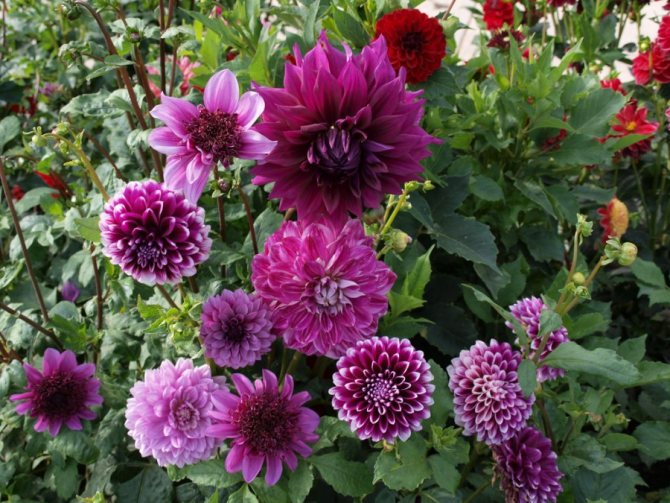

Brief content of the article:
The use of perennial dahlias in landscaping
Perennial dahlias are able to decorate any suburban area. Due to the variety of inflorescences, rich palette of colors, different heights of dahlia bushes, they are very suitable for the formation of a landscape. Tall varieties look very appropriate along walls or a fence. Low-growing dahlias are great for curb, solid planting, and to be placed in separate containers. You can form separate groups of dahlias to decorate the lawn, but they will look no less organic in combination with other flowers in the flower bed.
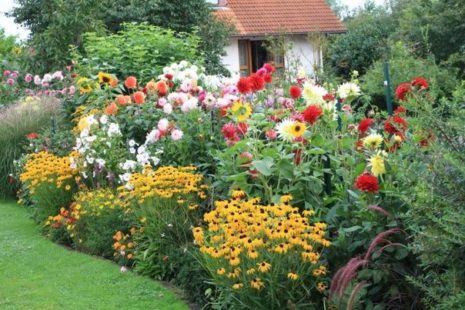

Versatility of colors
Few flowers can boast such a variety of varieties and species as dahlias. More than forty types of dahlias are officially credited. Let's note some of the popular varieties:
- simple. Usually one row of petals ranging from pink to orange and reddish is credited.
- anemone - may have one or more rows of petals, tubular;
- collar, bear this name due to the petals, similar to small cream-colored collars;
- peony dahlias.


The name itself makes it clear that the shape resembles peony flowers, pink tones;
- decorative types of these flowers have double inflorescences. Can be as large as small;
- spherical - already have a more distinct rounded shape with many flattened branches;
- pompom dahlias resemble the previous species. The edges of the petals are rounded;
- cactus and semi-cactos dahlias acquire curled, sharp tips. Moreover, the color spectrum is much wider here;
- nymphaean - have a delicate pink or red color, a bit like lilies.
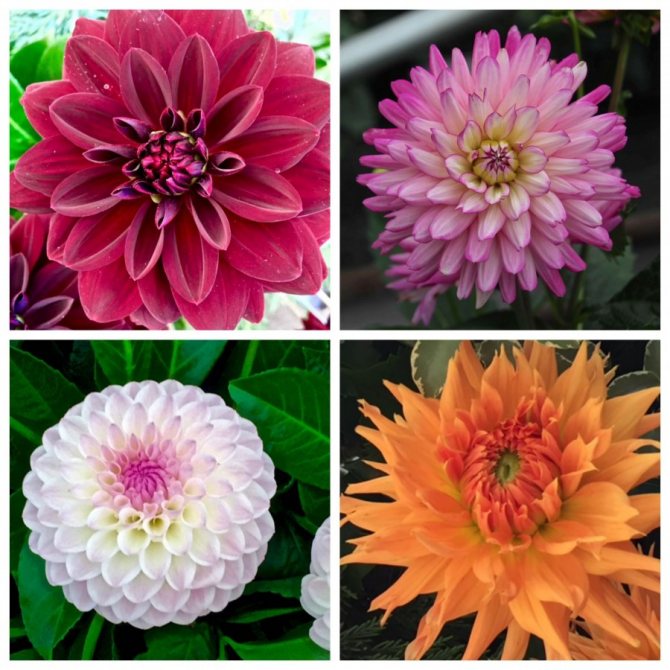

A large number of dahlia photos will help to understand in more detail the external differences.
Testimonials
Anna Zakharchuk:
“I couldn’t store dahlias before, so I didn’t grow them. Then they gave me a few tubers, and for four years now the flowers have made me happy. I store it with vegetables, just in a paper bag. In the spring I take it out and plant it in the same place. They do not require serious care, they grow excellently, they have to be tied up. I admire them every day. "
Svetlana Dronenko:
“We grow dahlias in the country. There are many of them, of various colors and sizes. I like the red balls the most. We rarely cut them, they quickly wither in a vase, we admire in the beds. We often exchange tubers with our neighbors. "
The benefits of flowers
Dahlias are prized not only for their unusual beauty, but also for their medicinal properties. Nature has endowed them with substances that can help rid the body of toxins and cholesterol.
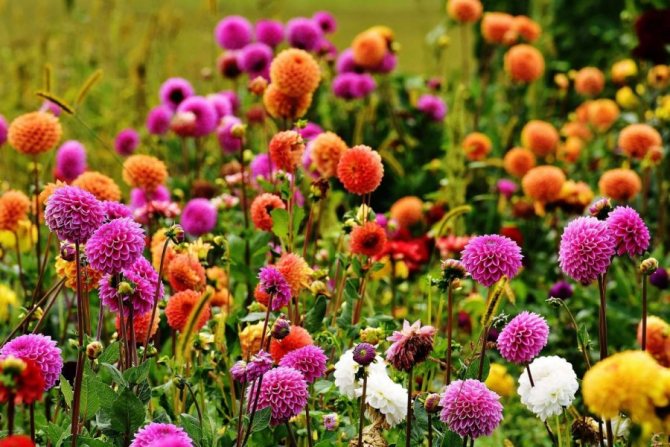

For diseases of the cardiovascular system and pancreas, it is useful to use decoctions from small buds of these flowers. Note that not only dahlia buds are used for medicinal purposes. Tincture of leaves and rhizomes will be a good prevention against diabetes.


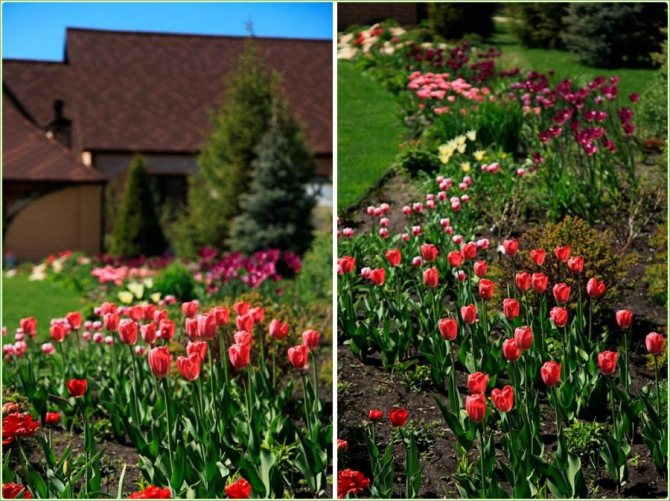

In addition to its delicate aroma and medical use, a bright flower can delight the fair sex and as a cosmetic product. A mixture of bud powder with honey and egg will give your hair shine and strength.
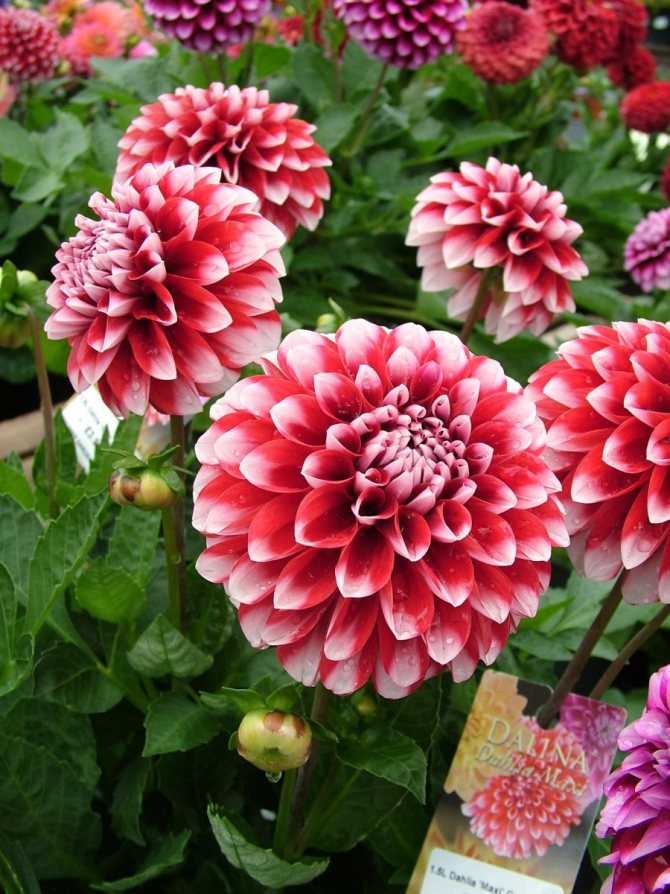

The face will glow with health if fresh leaves are applied to problem areas of the skin. The same method will help with cuts, as well as relieve acne.
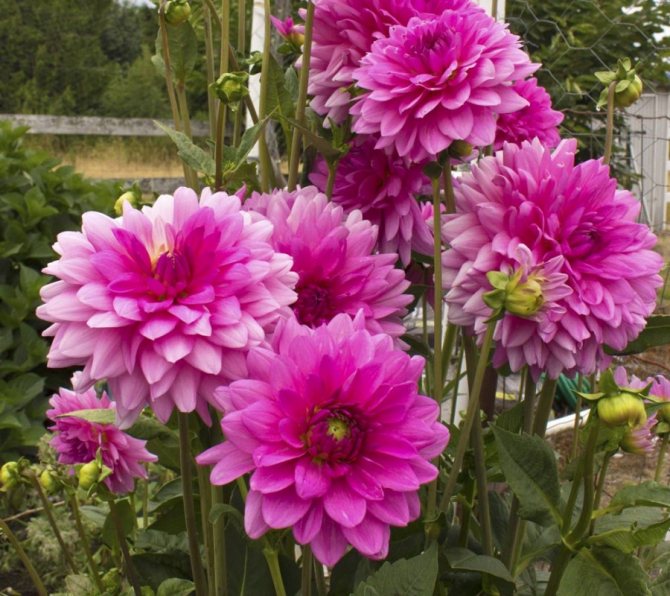

Annual dahlias from seeds: growing and care
Annual low-growing dahlias, in comparison with their long-lived cousins, are used as bordering flowers in the borders of flower beds with taller plants. One of the ways to get flowers on plants not by the end of summer, but much earlier, is to germinate from self-collected or purchased seeds.
It will be easy for a summer resident with experience in preparing seedlings for greenhouses to germinate dahlias in a plastic container: the process itself practically does not differ from the options for other crops. The main thing is to correctly determine the time of sowing dahlias for seedlings, when it is not too early to plant, but it is not too late. The very beginning of April is the optimal period.
Instructions for seedlings of dahlias: how to plant so that there is a result.
- put sand treated at high temperature into a container
- spread seeds over the surface
- sprinkle them with sand
- thoroughly moisturize
- send in a transparent plastic bag or home mini greenhouse
While maintaining a stable temperature of 25-27 C, shoots will appear in 10 days, which then (with the appearance of true leaves) must be dived into separate containers. The soil mixture for the further growth of plants is made up of sand, high moor peat and earth, before planting the shoots, it is spilled with a saturated pink solution of potassium permanganate.
Well-rooted, matured, hardened plants are assigned to the chosen place in May. So that your work does not disappear, with the threat of recurrent frosts, prepare an agrotechnical covering material - any types of dahlias are afraid of the cold.
Transitional
| Akita
|
| Pink giraffe
|
Growing problems
Novice growers are faced with various difficulties associated with the development of a new species - dahlia. It is not always possible to achieve flowering, planting plants are attacked by pests and viruses, and may die due to waterlogging. Do not forget about the fragility of the stem, its susceptibility to damage under wind gusts.
At the first signs of the appearance of damage to dahlias by insects, diseases, urgent measures are taken - the destruction of damaged parts of the plant, treatment with chemicals.


The choice of planting material
In addition to the variety and size of the inflorescences, when buying, you must carefully choose the planting material. Dahlias can be planted with seeds, cuttings (tubers) and seedlings.
Seeds: on the package indicate the group of dahlias and the height of the plant. It is very easy to grow a flower from seeds, it begins to bloom 45-50 days after planting.
You can buy flower seedlings. Seedlings in care are quite unpretentious, you just need to water on time. In the fall, many develop nodules that can be stored until next year.
Most often, delenki (tubers) are used for planting dahlias in the spring.
Dahlia tubers selection
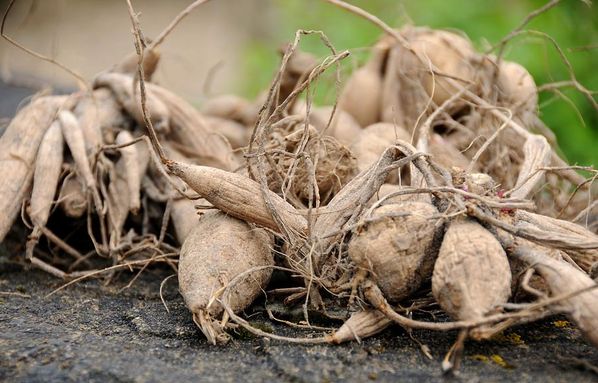

When buying by delenki, you must carefully study the planting material. It is necessary to pay attention to the size of the tuber, to the location of the buds of renewal.
- Root tubers should be dense, resilient.
- Healthy light brown tuber.
- There must be a piece of last year's stem.
- The root collar (the place where the root passes into the tuber) must be intact, intact. If it is frayed or blackened, then the tuber will not germinate, since sprouts are formed in the immediate vicinity of the root collar.
- If the tubers are divided, then they must have points of growth.
It is also a mistake to buy large "nests" of root tubers. Many leaves develop from them, but few flowers.
When choosing, you need to pay attention to the label and packaging. In addition to the picture (as a rule, the appearance of the flower is selected from it), the manufacturer puts information on the size of the flower on the packaging (indicated at the top in Latin letters) and indicates the height of the plant.
If the bag is too light, most likely the tubers have dried up, you can try to bring them back to life by putting them in wet sawdust or in water. It may not help, though. Therefore, it is better to refrain from buying such planting material.
Also, you should not buy a cut with shoots. Such a plant will begin to grow even before planting in the ground.
It happens that the tubers are covered with young white roots. They can be bought, but must be planted immediately.
You can often find old deals on sale. They are easy to distinguish - they differ in size, have a wrinkled surface. They can be used for flowering. But it will not work to get new planting material from them.
How to store tubers before planting
Dahlia tubers do not like dampness and can rot from an excess of moisture, and dry out in a hot place. It is best stored in a dark, cool place until planting (for example, in the refrigerator wrapped in damp paper).
They also store tubers in boxes, laying them on a layer of peat or sawdust. They are also covered with peat from above. Tubers are well stored in the sand.
Remember
- When to plant a dahlia depends on the region... Early June in mid-latitudes. At this time, the frost ends. In the south at the end of April. By this time, the soil is warm enough.
- Tall varieties of dahlias must be tied up... The stems of the plant are hollow. They break easily during gusts of wind. When planting in the soil, drive sticks next to the holes and tie the bushes as they grow.
- If the stem is broken, straighten it right away. and apply a tight bandage to the breakage site.
- After digging, disinfect the tubers... Planting material is better preserved.
Diseases
Dahlias attack a variety of diseases, usually viral or fungal, although this occurs sporadically. In rainy years, plants are susceptible to infection with fungal diseases, including:
- Gray mold - the fight is carried out by spraying the plants with Topsin M 500 SC (0.6%), Kaptan 50 WP (1%), Sumilex 500 SC (0.5%).
- Powdery mildew - a white bloom appears on the leaves, similar to flour diluted with water. For spraying, the drug Topaz is used.
- Rotting (sclerotinia) - the dahlia tuber becomes watery with an unpleasant odor, the tops of the leaves turn yellow and dry. Diseased tubers need to be burned. The remaining plants are sprayed 2-3 times every 7 days with Median 50 WP (broad spectrum fungicide). Before planting, the tubers can be prophylactically treated with copper 50 WP (0.5%) for 30 minutes.
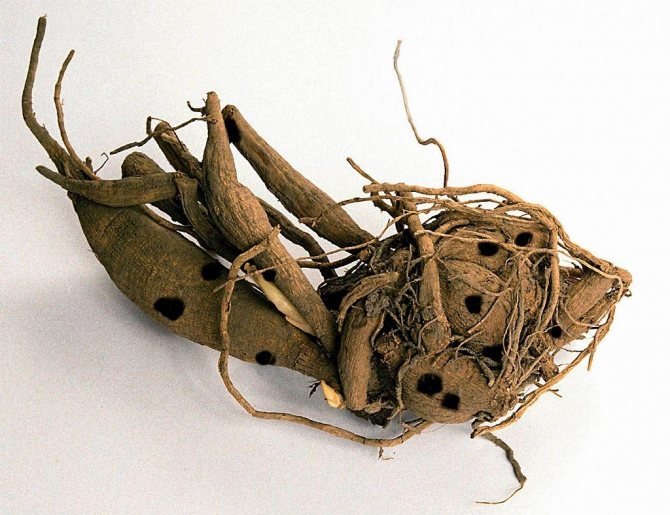

Photo. Sclerotinia on dahlia tubers
It is worth using chemical aerosols at the first symptoms of the disease.
How to choose the right dahlia tubers for planting?
There is nothing complicated or supernatural in this process. It is necessary to remove dried tubers and remove damaged areas by cutting. The main thing is to process the places of "injury". Most often they use ordinary brilliant green, a weak solution of potassium permanganate or ash. With the last material, you need to gently rub the required place.


Tuber processing
- And it is better to place all the tubers in a weak solution of potassium permanganate for 30 min-1 hour.
- Experienced gardeners have noted another way - this is an ash solution. It is necessary to pour ¼ bucket of ash with cold water and leave for 24 hours. Upper water and exploit to disinfect tubers. You need to place them for 2-3 hours.
- Those tubers that do not contain growth buds also require special attention. They are attached to the common center with thin spines. After landing on flower beds, they rot. Therefore, cut them without regret, it will not damage the bush.
How to propagate


The easiest way to propagate perennial dahlias is by dividing the tuber. By the way, such a procedure is beneficial to the plant - the defenses of the dahlia increase, the bush rejuvenates. With this method of reproduction, all varietal characteristics of the culture are fully preserved.
On a note! If you do not divide the tuber, dahlias will begin to degenerate. In the future, the plants will become shorter in growth, the quality of flowering will deteriorate.
It is customary to divide the tubers into parts in the spring, when the growth points are more noticeable, although no one forbids doing this in the fall. At least two buds should remain on each division. The larger the tuber, the greater the number of cuttings you can get from it. It is necessary to make division with a sharp sterile instrument. You can disinfect a knife by igniting it over a fire or wiping it with alcohol. Cuts on tubers are treated with wood ash or crushed coal. At the same time, during division, all dried and sluggish parts are removed.
How to divide dahlia tubers: video
Pests dangerous for dahlias
Harmful insects (meadow bug, aphids, thrips, spider mites) not only destroy dahlias, but also carry viral diseases. Some recipeshelping to get rid of them:
- treat 3-4 times a month with insecticide preparations ("Iskra", "Aktellik");
- to process dahlia, use karbofos or chlorophos;
- spray with a soapy solution consisting of 250-300 g of household soap and 10 liters of water;
- use tobacco infusion.
During flowering, dahlias are treated in the evening with decoctions of wormwood, celandine, so that the two-tails, working at night, do not damage the buds.
Young shoots are harmed by slugs, wood lice, caterpillars. It is recommended to collect them manually and destroy them. Chemicals can be used.
Nematodes are located on roots and stems. In places of their settlement, swellings appear. The leaves turn brown, die off.
Helpful advice.Marigolds planted near dahlias repel many pests.
When to dig dahlias


Experts advise not to rush to dig up dahlias. To survive the winter well, the tubers must ripen properly. This process lasts from spring to autumn. The longer the tubers stay in the ground, the better for them. If you are worried about early frost, just spud the plants. Let them sit in the ground a little longer.
Experienced summer residents leave dahlias in the ground until the first severe frosts and only then start digging. Now it is impossible to hesitate, it will be necessary to extract the tubers from the ground within the next 2-3 days. If you are in a hurry to close the summer season, you can dig up the tubers without waiting for the frost to hit. A few days in this case will not play a special role.
Description and characteristics of the flower
The plant belongs to the extensive family of Asteraceae or Compositae. The scientific name - Dahlia - comes from the name of the famous Swedish botanist Anders Dahl. Dahlias cultivated in gardens and parks are nothing more than a cultural hybrid obtained after the painstaking work of enthusiasts, multiple interspecific crosses.
Wild plants grow in Central and South America, they are very different from their offspring. More than 15 thousand species of dahlia are known in the world. Groups of flowers (about 10) are formed according to characteristic features.
The plant is perennial. The roots form a tuber. The dahlia stem is even and straight, it rises to a height of 2 meters. Leaves with a dense structure, dark green (less often purple) shade. The flowering period of the plant falls in August-September, so dahlias are a frequent and welcome guest in autumn bouquets and compositions.
The inflorescence of dahlias is basket-shaped, the petals of the flower are like tongues. With the onset of frost, the plants are removed from the soil, the stems are separated from the tubers and stored in a cool dry place. There are also "annual" flowers - those that are grown from seeds. The division is conditional, since in the fall, dahlias form tubers, which serve for subsequent planting, plant reproduction.


Where to plant dahlias
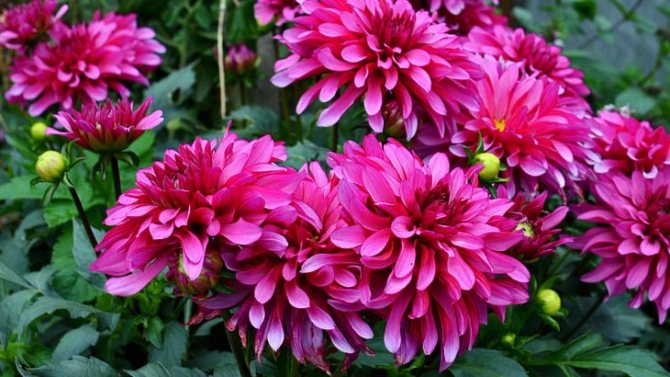

- Many are sure that dahlias are appropriate only in a country garden. In fact, this is a delusion. They can even be planted in a Japanese garden. It was in Japan that such masterpiece varieties as Tsuki Yori No Shina, Harlequin, and Akita were born.
- You can choose varieties for both a mixborder and a garden in a regular style. Fortunately, the breeders have tried and bred many varieties for every taste and color.
Sometimes the gardener would have planted a bush or two, but there are no more places for hergin, everything is planted with other flowers. But almost everyone has small corners for compositions with annuals. Here you can encroach on them. The result will only please. - In Europe, dahlias are planted in mixborders. They are especially fond of the Bishop of Llandaff variety - a beautiful bush with purple foliage and the simplest red chamomile flowers. Phloxes, geleniums, monards, crocosmia are planted next to dahlias. Yes, you can plant anything. Don't be afraid to experiment.
- If you have a composition of shrubs, or a lonely bush grows on the lawn, plant the dahlias there. Why not please yourself with bright colors at the end of summer? Such a neighborhood will not interfere with shrubs, on the contrary, it will draw attention to them.
- Do you have a corner with rhododendrons and conifers? Plant a bush next to them. It may not be a designer thing, but we are ordinary people. We want bright colors, it is boring to look at greenery after rhododendrons have faded.
- If you don't want to plant in the ground, put a pots with low-growing dahlias. It seems to me that this is even more original. Against the backdrop of greenery, any color will look great.
- Do you have a vegetable garden? Excellent! You can even make a dahlia bed. Or plant them to decorate vegetable plantings. You can make a border by including marigolds and "marigolds" there. Both fun and beautiful!
- There is no place on the site at all? Then plant the dahlias in containers.Buy low varieties, or even medium-sized ones, the size depends on the size of the container. After all, we plant so petunias, pelargoniums, and why dahlias are not allowed? And you can put such a pot anywhere you want.


Tip: if there is no room at all in a mixborder or flower garden, plant dahlias instead of faded tulips. Only tulips will have to be planted in advance in trellised containers, and after flowering, take them out and dig in a shady corner to ripen the bulbs.
By the way, mice will not eat them, and the appearance of a flower garden will not be spoiled by yellowing leaves.
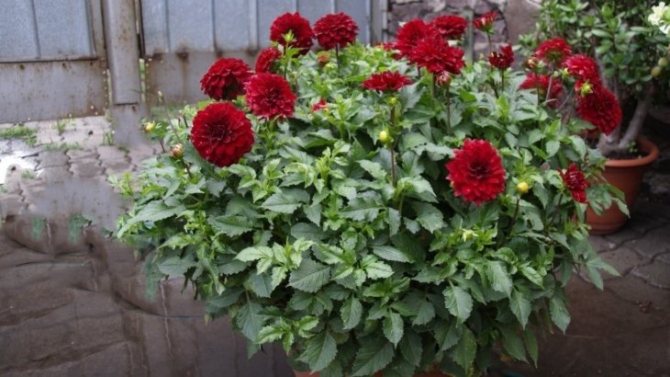

Storing dahlias in winter
Prepared tubers in winter are stored in boxes, the bottom of which is covered with a layer of earth 3 cm thick. The tubers must also be completely covered with soil on top. Boxes with planting material are kept in storage with high air humidity at a temperature of + 1 + 7 degrees (Figure 6).


Figure 6. Features of winter storage of tubers
Sometimes it is practiced to store tubers in a coated form, that is, covered with a layer of clay and dried. In an apartment, dahlia planting material is stored in tightly tied plastic bags, sprinkling the tubers with any dry insulating material, for example, sawdust, ash, peat, sand. The safest way to store tubers in warm rooms is to use paraffin wax. The planting material is dipped in melted paraffin, which, after drying, forms a reliable layer that not only protects the tubers from unfavorable external factors, but also prevents the risk of drying out.
Frequently asked Questions
- Why do dahlias turn yellow?
One of the reasons is flooding. The parts of the root that absorb moisture could rot and even die off - in the next watering, stimulate the roots with a rooting agent (Kornevin, for example). Another reason is pests, inspect the plant and treat it with an appropriate preparation. Another option is lack of nutrition. Feed the plant, avoiding nitrogen fertilizers. And the simplest thing is the lack of watering.
- Why don't dahlias grow?
First, the planting material was stored incorrectly or was chosen incorrectly. The second is fungal diseases or pests. There may also be a lack of watering and nutrients in the soil, as well as low temperatures.
- Why do dahlias bloom late?
The reason is the excess of nitrogen in the soil.
How to collect seeds from annual varieties
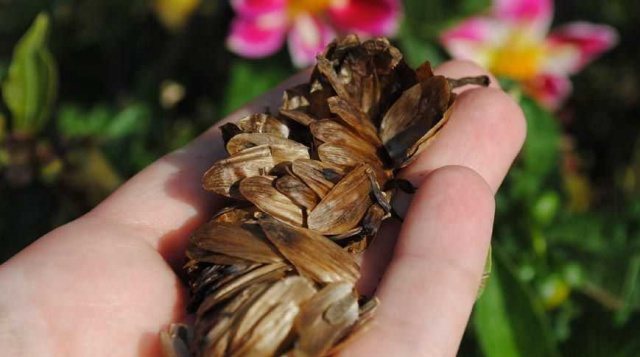

In August, these flowers form a green seed box. When ripe, around mid-September, it will take on a dark brown color. Photo:
- Leave to collect seeds - the first large and beautiful inflorescences.
- Cut off the entire dried flower in warm weather... In a ventilated area, leave to ripen for several days. Correctly dried inflorescences are well peeled off by hand.
- Select large and strong seedlings... Pack in paper bags or boxes, sign. Store at a temperature of +10 ° C and humidity no more than 60%.
Semi-cactus
| Ice Princess
|
| Adlerstein
|
Diseases and pests
| Leaf spot Symptoms:
Treatment:
|
| Gray rot Symptoms:
Treatment:
|
| Aphids or Aphididae Symptoms:
Treatment:
|
Preparation and storage of tubers
You can start work from the end of September. As soon as the stems die off, the perennial dahlia tubers must be carefully removed from the ground and provided with the necessary conditions for further storage.
Work should be done in dry weather. The stems should be cut 15 cm from the ground. The bushes must be dug in. To get the tubers, you need a pitchfork. Then they need to be cleaned of the earth, dried.


Tubers must be treated with a solution of potassium permanganate. After that, they need to be dried. Tubers should be placed in a room with a temperature of up to -5 degrees or placed in a refrigerator.
For storage, you can use sawdust, sand, peat. Alternatively, you can use cling film. The boxes must be filled with one of the selected components and the tubers must be placed in them.


